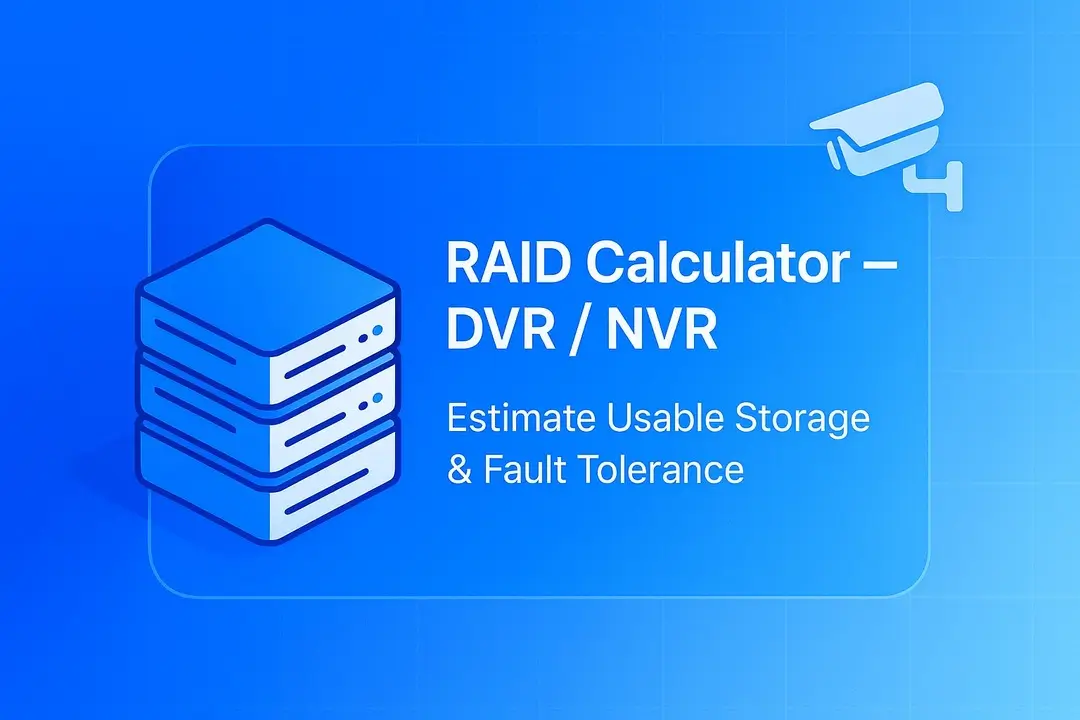Managing storage for CCTV systems is different from general IT storage. Long retention windows, continuous recording and large sequential writes mean installers and integrators need fast, simple tools to estimate usable capacity and redundancy for DVRs and NVRs. This RAID Calculator is built specifically for that: self-contained, WordPress-friendly and tuned for CCTV deployments.
🗄️ RAID Calculator — DVR / NVR
Estimate usable storage, fault tolerance and efficiency for CCTV NVR/DVR arrays (RAID 5 & RAID 6).
More Tools: Online Tools for CCTV Security Systems

Why cctv raid calculator helps
- Tailored for CCTV/NVR use cases — shows how many disks you can actually use after parity and hot-spares.
- Supports RAID-5 and RAID-6 (common in DVR/NVR hardware).
- Uses binary units (1 TB = 1024 GB) — the standard most HDD vendors and NVRs report.
- Self-contained, scoped CSS — safe to paste into a WordPress Custom HTML block without disturbing your theme.
How it works (simple)
- Enter number of disks — total physical drives in the array.
- Enter disk size — in TB or GB. (Binary TB: 1 TB = 1024 GB)
- Choose RAID level — RAID-5 uses 1 parity disk, RAID-6 uses 2 parity disks.
- Choose Hot-spare (optional) — reserving a disk as hot-spare reduces usable capacity by one disk but helps faster, automatic rebuilds.
- Click Calculate — the tool displays:
- Usable disks (how many disks’ capacity is available for storage),
- Fault tolerance (how many disks can fail without data loss),
- Usable storage (human-readable GB/TB),
- Efficiency (usable capacity ÷ total raw capacity).
Formula used (conceptual):
Usable disks = Total disks − parity − hot_spare
Usable storage = Usable disks × disk_size
Practical examples
- 8 × 4 TB, RAID-6, no hot-spare: usable disks = 8 − 2 = 6 → usable = 6 × 4 TB = 24 TB (binary)
- 6 × 4 TB, RAID-5, 1 hot-spare: usable disks = 6 − 1 − 1 = 4 → usable = 4 × 4 TB = 16 TB
Tip: For large arrays (≥8 disks) we commonly recommend RAID-6 to reduce the risk during rebuilds — a second parity disk helps survive a second failure while rebuilding.
When to use RAID-5 vs RAID-6
- RAID-5 (1 parity): good for small arrays (3–5 disks) where capacity is prioritized and rebuild times are short. Not recommended for larger arrays due to rebuild risk.
- RAID-6 (2 parity): better for medium to large arrays (≥6–8 disks) where resilience during long rebuilds matters more than a small capacity hit.
Limitations & caveats
- This calculator shows logical usable capacity assuming identical disk sizes and no overhead for filesystem, metadata or SMART/reserved space. Real usable capacity in your NVR may differ slightly.
- It does not account for RAID controller overhead, RAID stripe alignment, or RAID controller metadata space. For final planning, always reserve an additional safety margin (5–10%) for metadata, OS partitions and reserved sectors.
- Use drive models and manufacturer specs for exact performance and usable numbers when buying drives.
Accessibility & embedding
- The tool is a single self-contained HTML + CSS + JS snippet (scoped) that can be pasted into a WordPress Custom HTML block or included in a template. It won’t pollute your theme styles because all CSS is scoped under a single root element.
FAQ
Q: Does the tool calculate decimal TB (1000 GB)?
A: No — it uses binary TB (1 TB = 1024 GB). If you need decimal units for procurement comparisons, multiply binary TB values accordingly or contact us for an alternate view.
Q: Is hot-spare capacity included in usable numbers?
A: No — the hot-spare is reserved. Selecting 1 hot-spare reduces usable capacity by one disk.
Q: Can I use drives of different sizes?
A: This calculator assumes identical disk sizes. Mixed-size arrays are complex; many RAID controllers use the smallest disk size across the array — plan accordingly.